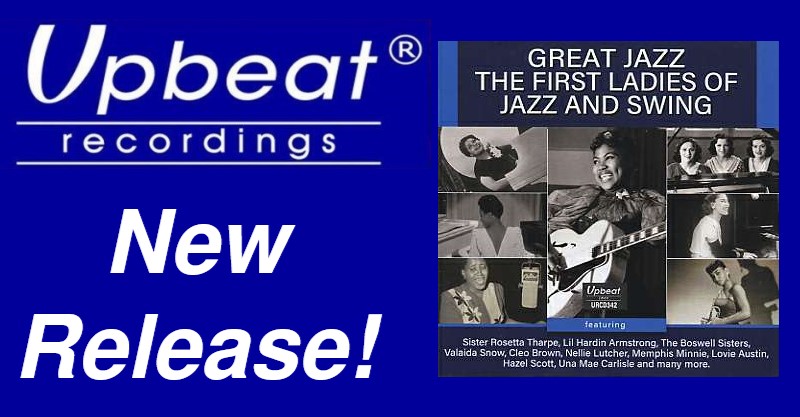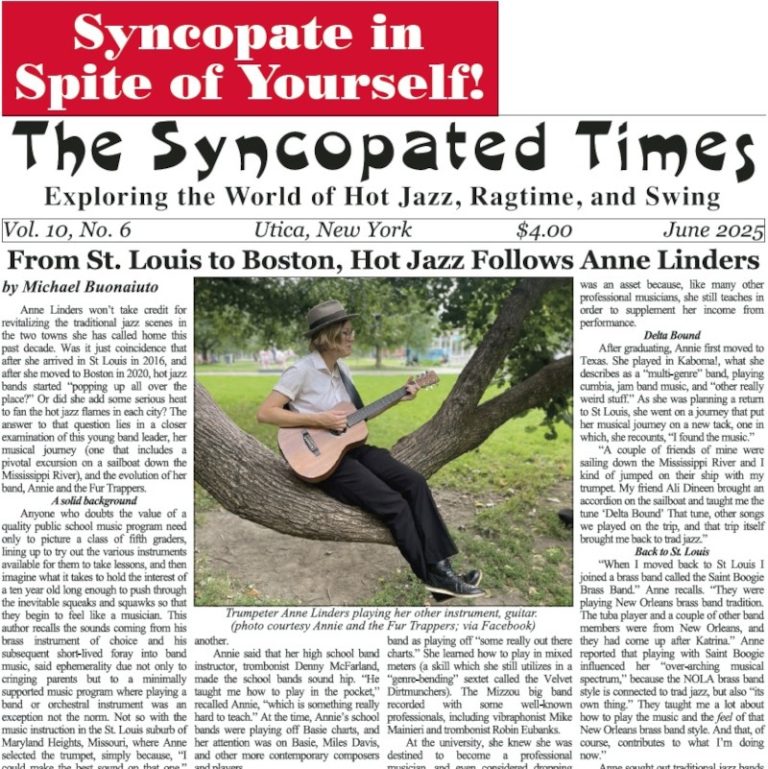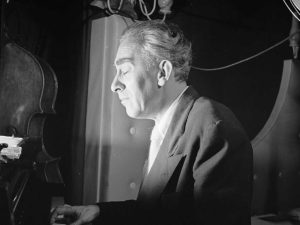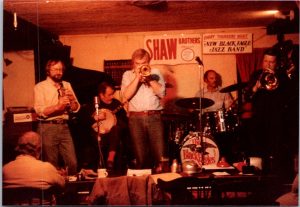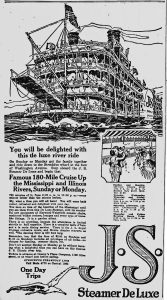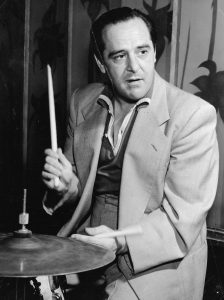Jeff Barnhart: This column is a special one for me! Several years ago, Hal introduced me to the music of Frank Melrose (it’s truly a highlight to play Melrose’s “Market Street Jive” with Hal) and to his daughter, Ida Melrose (Shoufler). Hal and I call her “Aunt Ida” and to her we are “Nephew Hal” and “Nephew Jeff.” How did you meet Ida, Hal?
Hal Smith: In the early 2000s, Ida made contact with pianist Butch Thompson. Butch, knowing of my interest in Frank Melrose’s music, put me in touch with Ida.
JB: Aunt Ida, that meeting changed your life, didn’t it? You hadn’t known your father’s music firsthand.
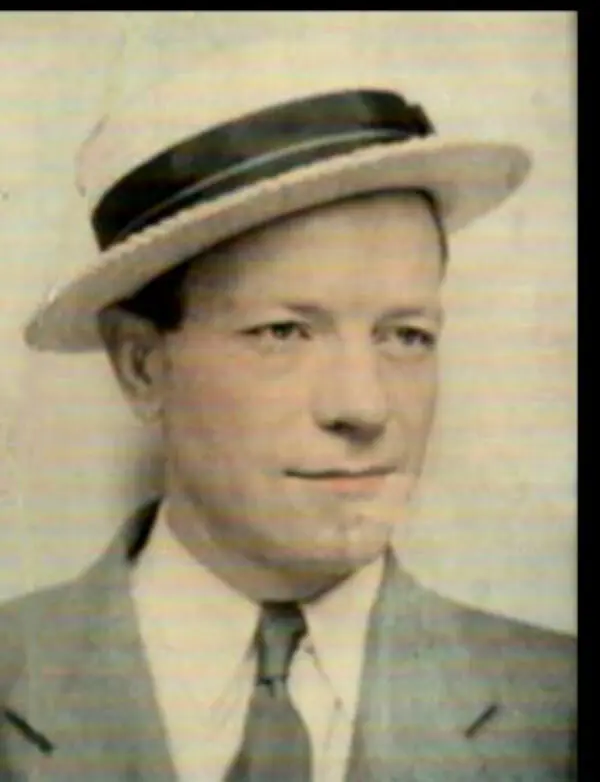
Ida Melrose Shoufler: I‘m the youngest, and only surviving child, of three children born to Frank and Frances Melrose. I was only two years old when my dad died. I didn’t remember him at all. When my mother told me about my dad it was like she was talking about someone in the old family history. He didn’t seem real to me until 20+ years ago when Hal Smith and Mike Meddings came into my life. I was thrilled to hear they knew there was something special about my father’s piano playing. Without them I would never have known.
You contacted me by email, Nephew Hal. I still have that first letter, I printed it out and it is safe in my tote of treasures. You sent me several cassettes of my dad playing solo and with bands. Those are also safe in my box of treasures. I think, without getting the letter out, that we connected in 1998. Twenty three years ago!! Now you are my beloved nephew and I am so grateful for everything you have done for me.
JB: While Hal is blushing from his (deserved) praise, what did you do next to learn more about your Dad?
IMS: In a hurry at Best Buy I grabbed a CD called “A Piano Anthology.” I didn’t even look to see who the recording artists were: it was piano! I was more than excited to see that the fourth song was “Jelly Roll Stomp“, and my father was the artist. I must have listened to it a hundred times!

JB: Any time you’d like to interject here, Aunt Ida, please do! For now, how about you lay some facts about Kansas City Frank on us, Cousin Hal?
HS: For many years, pianist and composer Frank Melrose was familiar only to record collectors and students of Chicago jazz history. But thanks to a popular cartoon by Robert Crumb (“Kansas City Frank”), the late Mike Meddings’ “Hot Piano” website, CD reissues of Melrose recordings and contemporary public performances of his compositions, Frank Melrose is gaining a well-deserved reputation as one of the most distinctive stylists of the Classic Jazz Era.
Franklin Taft Melrose was born in Sumner, Illinois on Nov. 26, 1907. In addition to father Frank H. and mother Mollie, Frank’s family included sisters Muriel, Mamie and Belle; younger brother Lee and two elder brothers—Lester and Walter—who later formed the Melrose Brothers Music Company in Chicago along with M.L. Blumenthal, a/k/a Marty Bloom.
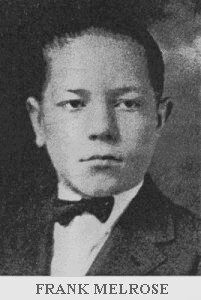 Frank took up the violin as a pre-teen, but eventually switched to piano. He met Jelly Roll Morton, whose compositions were top sellers at the Melrose family’s music publishing business. Morton offered to teach Frank to play “Jelly Roll Style” and the young man gratefully accepted.
Frank took up the violin as a pre-teen, but eventually switched to piano. He met Jelly Roll Morton, whose compositions were top sellers at the Melrose family’s music publishing business. Morton offered to teach Frank to play “Jelly Roll Style” and the young man gratefully accepted.
Melrose records such as “Transatlantic Stomp” and “Market Street Jive” from the late 1920s show the unmistakable influence of Jelly Roll Morton. But even though Morton continued to be his greatest inspiration, Melrose was aware of the sounds produced by other great pianists in Chicago and elsewhere. Some online sources indicate that Melrose left Chicago in the mid-1920s to work in other locations—including Kansas City. If that is the case, it is likely that he was able to hear the great band led by Bennie Moten and to absorb the wonderful ragtime-tinged piano style that Moten played. Comparison of Moten’s solos on records such as “Kater Street Rag” and Melrose’s on “Market Street Jive” illustrate quite a few similarities in melodic ideas, phrasing, rhythmic feel and keyboard techniques (like short glissandos between notes). There is also the matter of Melrose’s nickname—“Kansas City Frank.”
Another pianist who likely influenced Melrose’s playing was Jimmy Blythe, a Kentucky transplant who recorded extensively in the 1920s and was quite active on the Chicago jazz scene. The Dixie Four’s “Five O’Clock Stomp” with Blythe on piano includes many phrases heard on Melrose’s recordings from the same era.
Melrose synthesized all these influences into a characteristic style of his own; one which continued to evolve well into the early 1940s. His “stomp” playing was a perfect fit for the Beale Street Washboard Band, E.C. Cobb and his Grains of Corn, the Cellar Boys, and his own “Kansas City Frank’s Tin Roof Stompers.” He was recording with many of the best jazzmen in Chicago, including Johnny and Baby Dodds; Jimmy Bertrand; Junie Cobb; Frank Teschemacher; Bud Freeman; George Wettling; and Wingy Manone. He was also writing songs. “My Gal” was recorded by his mentor Jelly Roll Morton and “Kentucky Blues” was recorded by the State Street Ramblers. Some record labels from the late 1920s and early 1930s only list “Melrose” as the composer, but there is at least a good chance that some of the numbers were written by Frank—rather than Walter or Lester.
JB: Let’s take a listen to some of the music produced by Melrose and the various groups you must listed, Hal, starting with “Transatlantic Stomp,” by E.C. Cobb and His Corn-Eaters.
HS: The first chorus on this one must have fooled a lot of researchers and discographers when they became aware of it. The piano playing is very Morton-like throughout the whole record.
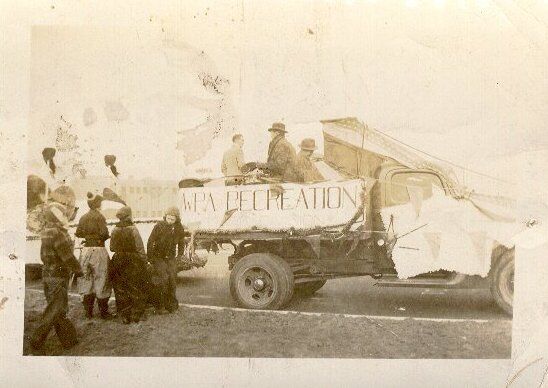
JB: The second section uses the same chord progression as “Twelfth Street Rag,” and they make the most of those familiar changes! The final chorus has Melrose romping in grand barrelhouse style, leading the band to the finish! As wonderful as is our first track, this next one includes two brothers who are much better known to our readers! Hal what are your observations of The Beale Street Washboard Band’s “Forty and Tight?”
HS: Frank was recording with jazz royalty! Johnny and Baby Dodds (playing washboard) were really at the top of their game here. Trumpeter Herb Morand turned in some fine ensemble and solo work and there is a characteristic piano chorus. Too bad it wasn’t a full solo!
JB: Let’s move from this well-known jazz side to an obscure but VERY hot tune, “Barrelhouse Stomp“, this time featuring KC Frank with The Cellar Boys, another group of stellar musicians.
HS: This composer of this song is “Melrose” (which one)? It was also recorded by Junie Cobb and others. Once again, Frank was recording with some of the top jazzmen in Chicago—including Frank Teschemacher on clarinet (his solo sounds like a cross between Pee Wee Russell and Johnny Dodds), Bud Freeman on tenor sax, Wingy Manone on trumpet and George Wettling on drums. This time, Frank was able to play a full solo and he made the most of it. I thought I heard some Jimmy Blythe licks on “Forty and Tight” and they are in evidence here as well, though the Morton influence is still the most prominent. The accordion player has often been listed in discographies as “Charles Melrose,” but Aunt Ida assures us there was no such person!
JB: Crazy! Who was it really, then? Next, it’s always interesting to listen to a side under our subject’s leadership so let’s dig into “St. Louis Bound” by Kansas City Frank’s Tin Roof Stompers. There are a couple of unusual instruments in here, Hal! Xylophone and do I hear a bassoon or a Goofus or something like that?
HS: What you’re hearing is a baritone sax (in place of string bass, tuba or bass sax) and the percussion wizard Jimmy Bertrand doubling on drums, xylophone and whistle. We also heard him earlier, on “Transatlantic Stomp.” On this record, Frank modulates to the key of Bb and plays a very bluesy solo.
JB: Let’s move to some of Melrose’s solo sides (or with drum accompaniment).
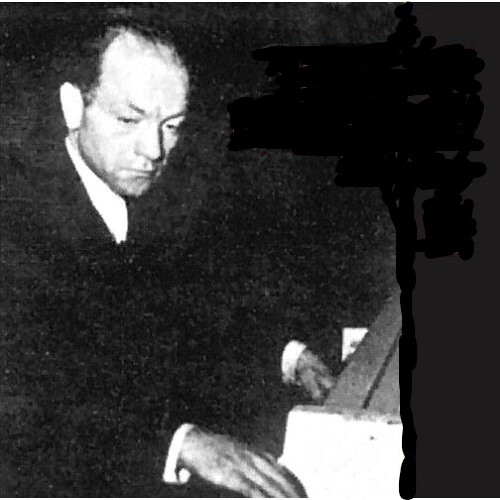 HS: In 1929, Melrose recorded his own “Jelly Roll Stomp” and “Pass The Jug” for both the Gennett and Brunswick labels, accompanied by drummer Tommy Taylor playing odd-sounding traps. He also recorded several piano solos, which were only available to dedicated collectors thanks to the efforts of Chicago jazz activist John Steiner. Two of the sides—“Rock My Soul” and “Whoopee Stomp”—were actually recorded much later, with Knocky Parker and John “Jax” Lucas impersonating Melrose and Taylor, respectively. But other sides, like “Piano Breakdown” and “Market Street Jive” would have been lost forever without Steiner’s interest in the music.
HS: In 1929, Melrose recorded his own “Jelly Roll Stomp” and “Pass The Jug” for both the Gennett and Brunswick labels, accompanied by drummer Tommy Taylor playing odd-sounding traps. He also recorded several piano solos, which were only available to dedicated collectors thanks to the efforts of Chicago jazz activist John Steiner. Two of the sides—“Rock My Soul” and “Whoopee Stomp”—were actually recorded much later, with Knocky Parker and John “Jax” Lucas impersonating Melrose and Taylor, respectively. But other sides, like “Piano Breakdown” and “Market Street Jive” would have been lost forever without Steiner’s interest in the music.
IMS: My mother knew John Steiner, record collector and record producer. I managed to find his email. I wrote to him, told him who I was and gave him my phone number. He called me soon after he received my email. He sent me a cassette of my father playing, and my mother too. There was just one by mom. She was singing and playing “Congress Avenue.” He said he would be sending more. Unfortunately, I didn’t receive any more before his passing in 2001. I was grateful for the one I did receive.
JB: So your Mom played as well, Aunt Ida? Could you tell us about that?
IMS: Well, I did, too! And my sister Francene! My mother had learned everything she knew about the piano from my father. She began playing at a small bar called John’s Bar in Cedar Lake, Indiana, in 1962. She soon had the place packed every Friday and Saturday. This led to jobs around the lake which was a resort town and had several bars. I think she played at just about all of them. She played solo at first and then was asked to play with a small band. What started out as just weekends became three or four nights a week. They were good!!
When she moved to Illinois to be closer to me she would play my piano. I can still hear her style. The resemblance to my dad’s style was so clear. I loved to hear her play. She played by ear, not being able to read music at all. The smile on her face the first time she heard me playing along with the recordings I had received from Hal was something I won’t ever forget. I can’t read a note of music either. I play by ear just like my mother did.
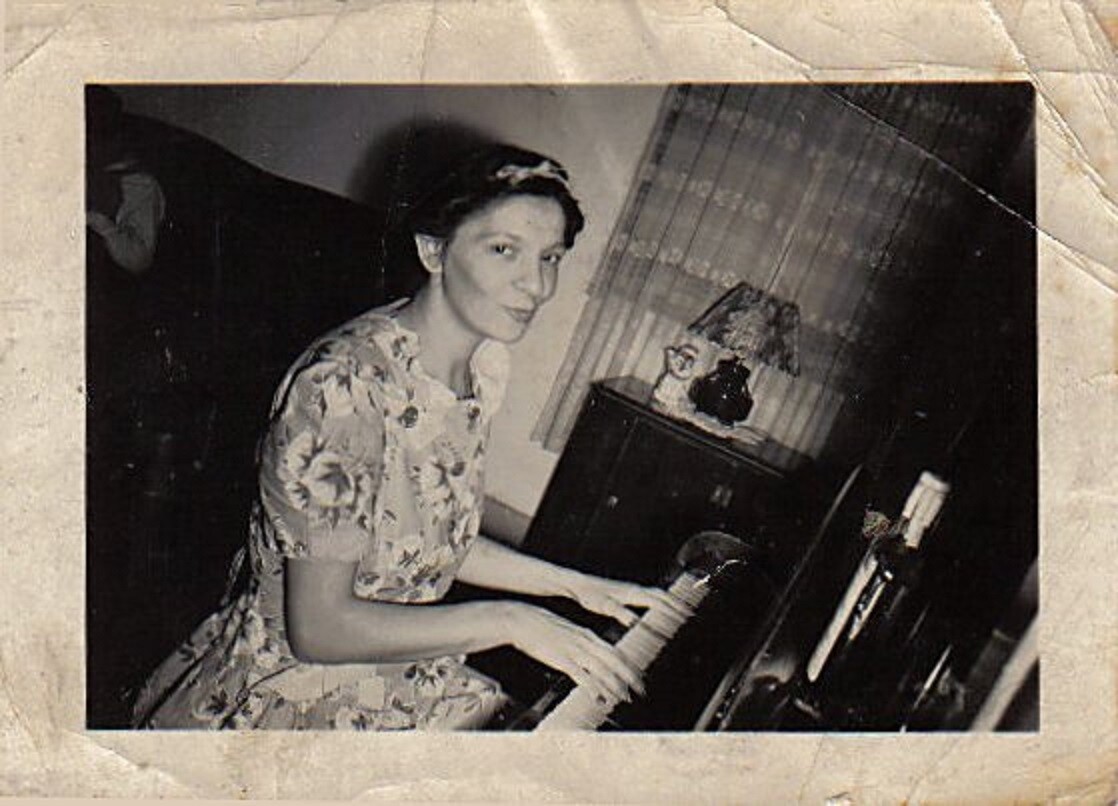
I must mention my sister Francene and the piano. She played by ear also but taught herself to read music. Her first playing jobs led to playing all over this part of the state. She was definitely her father’s child! My mother was so proud of her, as was I. I know my dad had to be smiling down on her! I often wonder how far my father would have made it up the ladder as a boogie and blues piano player. Also. how different my life would have been had he lived.
JB: Aunt Ida, I can only imagine! You mention boogie and blues and that reminds me, Hal, you’ve referenced “Market Street Jive” three times so far. It was the first tune of Melrose’s you introduced me too and I had a ball learning it; it has its share of boogie and blues in it! In fact, one chorus beats out a boogie bass with a repeated right-hand chord that predates Jerry Lee Lewis by nearly three decades!
HS: “Market Street” knocks me out every time I hear it. I think this is the most Morton-like recording Frank ever made; even more so than “Jelly Roll Stomp!” How about that modulation to Eb which quotes Morton’s “Freakish?” However, I should mention that—despite the almost non-stop Morton phrases—during the trio strain of “Market Street,” some listeners may note a similarity to Bennie Moten’s piano solo on “Kater Street Rag.”
By the way, Aunt Ida…this is the first composition by your dad that you heard Jeff play—at the Bix Festival in 2016!
JB: Moving on to “Jelly Roll Stomp,” the first thing I notice is that the first several choruses are derivative of “Market Street Jive” (in fact at first I thought I was listening to that piece, simply sped up). When Melrose gets to the trio 55 seconds in, he goes through four different themes, each good enough to serve as its own stand-alone tune!
HS: Yes, indeed. This is one of Frank’s best records. So characteristic; lots of Morton (of course) and also hints of the other great pianists who were active in Chicago during the late 1920s. But ultimately, it’s a great illustration of how Frank blended many influences into his own style. And I wish I could have watched Tommy Taylor drumming, to see what instrument he was using that produced all those cool sounds!
JB: Our next tune stands alone, not just among the three solos (with drum accompaniment) we are examining, but all of Melrose’s output, wouldn’t you agree, Hal?
HS: I agree! “Pass The Jug” is probably Frank’s best-known composition—thanks largely to cartoonist R. Crumb, who used the song title for his famous cartoon which features Kansas City Frank. “Pass The Jug” includes many of the common themes heard in recordings by South Side Chicago bands. Very hot barrelhouse style piano. I hear Jelly Roll Morton, Jimmy Blythe, Alex Hill, Bennie Moten and of course Frank Melrose.
JB: I do, too! I need to learn that one and play it with YOU! While Melrose absorbed and continued to utilize the styles of the 1920s pianists you list, his style continued to evolve as well.
HS: Beginning in the late 1930s, Frank Melrose made recordings (including non-commercial sides) with cornetist Pete Daily. Tracks like “New Orleans Joys” showed that the Morton influence was still strong. “Bluesiana” illustrated Melrose’s continuing talent as a composer. The piano solo on “Sugar Foot Strut” demonstrated that Frank was listening to Fats Waller, Earl Hines and Joe Sullivan. There were additional solo records, including a startling version of Hoagy Carmichael’s “Cosmics” and a gritty, South Side rendering of Wayne King’s “Josephine.”
JB: Let’s check out some of the Melrose-Daily sides! One you didn’t mention was “Original Stomp,” but I love that one, Hal!
HS: This was composed by Frank Melrose, and I think it has another title besides “Original Stomp.” It is a “good time” stomp that sounds as if it could have been played a few years earlier by the Cellar Boys. It certainly sounds like it was composed earlier than the recording date of 1940. Great solos by the horns and Frank’s piano solo fits the affectionate label that John Steiner used to describe the Frank Melrose piano style: “squirrely.”
JB: OK, let’s get to one of Melrose’s compositions, “Bluesiana” by the same group:
HS: I love this one. I’ll never forget playing it with Jon Doyle and watching the dancers stop dead in their tracks and crowd around the bandstand with eyes wide. They had never heard a song like this! It sure proves that Frank Melrose knew how to put together a wailing blues ballad on a par with “Have You Ever Felt That Way?” and “You Let Me Down.”
JB: Or “Blue Prelude.” “Bluesiana” has that same emotional punch. Our final piece by this assemblage stomps and swings as well as struts!
HS: “Sugar Foot Strut” was recorded by the group that Melrose described as his “dream band.” Pete Daily was the cornetist, and he provided a surefooted lead throughout. There are excellent solos by Daily, as well as the clarinetist, bassist and drummer—and Frank! The piano solo is amazing, kind of a history of classic jazz styles. I hear Morton, Bix, Blythe, Waller, Hill, Hines, Sullivan and it all comes out as “Frank Melrose!”
Aunt Ida, if your dad had lived just a little longer, you probably would have been able to hear this band in person!
The life of a professional musician has always been difficult, and it was even more of a struggle for one who was devoted to playing hot jazz. Still, Frank Melrose managed to raise a family on his meager income. The Melroses lived in Hammond, Indiana—just across the state line from Metropolitan Chicago.
In 1941, Frank Melrose made his final recordings—with clarinetist Bud Jacobson’s Jungle Kings. This ensemble, taking its name from a 1927 recording band which included Muggsy Spanier, Frank Teschemacher, Joe Sullivan, Eddie Condon, and others, played exuberant Chicago Jazz; mainly original compositions. During the Labor Day weekend, 1941, Frank Melrose was murdered. The circumstances remain a mystery to this day. Wife Frances, daughters Ida and Francene, and son Franklin Jr. were left behind.
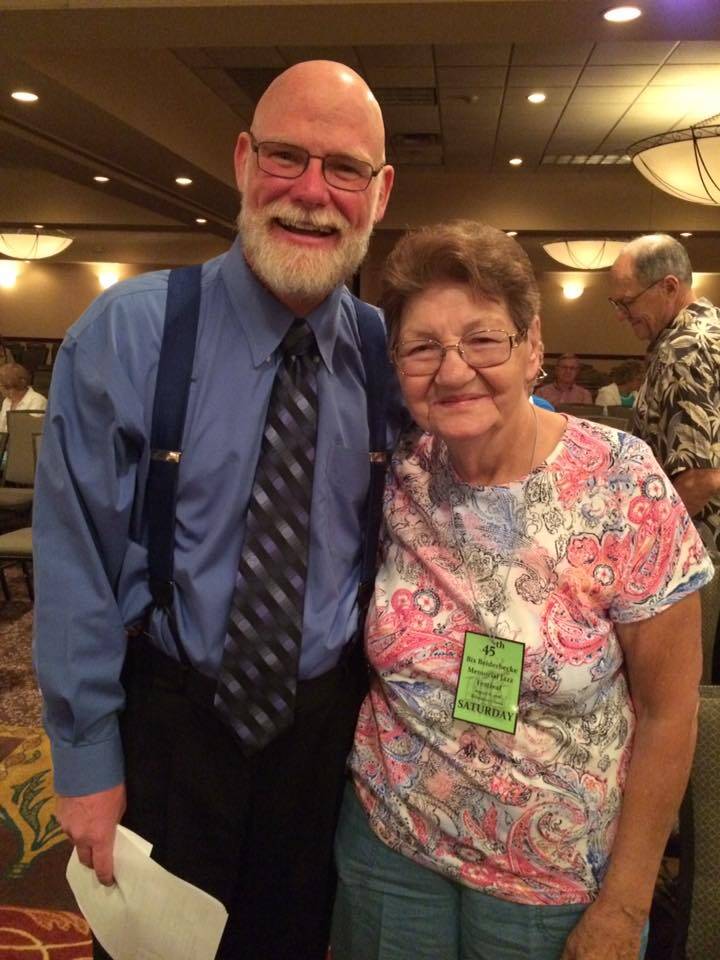
JB: And Aunt Ida is our link to this fantastic musician, Hal. Aunt Ida, in addition to receiving recordings of your father, what were other results of your happy encounter with Hal?
IMS: My “father” became very real to me, he was MY DAD!!! His music began to surface after that. Since then so many musicians became my friends, one being Ray Skjelbred, who plays piano with a style all his own. He has researched my dad’s life and probably knows as much about him as I do. Much to my delight Ray plays some of my father’s music to this day. Also, other soloists and bands do the same. I feel very humbled and grateful to these musicians. Especially Hal Smith and Jeff Barnhart. I am so blessed!
JB: As are we to have you in our lives, Aunt Ida, and to have you reminisce with us! For those interested in hearing more sides of Kansas City Frank Melrose, I’d point you to his work on Black Swan BSCD 35 (“Jelly Roll Stomp”) and Delmark DE 245 (“Bluesiana”). Hal, over to you for final comments and revealing next month’s topic.
HS: Jeff, we mentioned Lu Watters briefly in that article about our musical origins. Why don’t we discuss Lu’s music in depth?
JB: That will be perfect, Hal! I’ve always been thrilled by the two-trumpet sound, and all that comes with it! Let’s do it!
Jeff Barnhart is an internationally renowned pianist, vocalist, arranger, bandleader, recording artist, ASCAP composer, educator and entertainer. Visit him online atwww.jeffbarnhart.com. Email: Mysticrag@aol.com
Hal Smith is an Arkansas-based drummer and writer. He leads the El Dorado Jazz Band and the
Mortonia Seven and works with a variety of jazz and swing bands. Visit him online at
halsmithmusic.com




